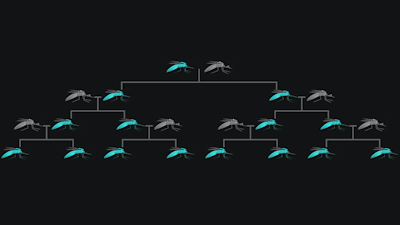Since the 1940s, researchers have thought of using gene drives to eradicate populations of pests and disease vectors, and to reduce or eliminate invasive species that wreak havoc on natural ecosystems. The idea of a gene drive stems from nature itself, where in sexually reproducing organisms a certain version of a gene is preferentially passed on to the next generation to over time become the dominant one in a population. Deployed willfully in human intervention efforts, a propagated dominant gene modification could, for example, by biassing the production of one sex over the other over many generations, force a deleterious disease vector to decline and lose its dangerous potential.
Wyss Institute researchers have leveraged the versatile RNA-guided genome editing tool CRISPR-Cas9, which they previously helped develop, as a part of synthetic DNA-modifying gene drives that in principle can swipe across large populations, potentially changing gender ratios or other biological traits in the process.
Our proposal represents a potentially powerful ecosystem management tool for global sustainability, but one that carries with it new concerns, as with any emerging technology.
These new types of synthetic gene drives could alter insect populations that spread diseases such as malaria, schistosomiasis, dengue and Lyme, protect at-risk ecosystems from the spread of destructive invasive species, or improve sustainability in agriculture by reducing the need for and toxicity of pesticides and herbicides. For more detailed information see our Frequently Asked Questions page.
On another venue, Wyss Institute researchers have also engineered gene drives that can be used to investigate pathogenic fungi and to identify new drug resistance mechanisms. A recent study showed, that the technology can be used to fast and efficiently delete both copies of a gene or of pairs of genes of the fungal pathogen Candida albicans, whose genome has been notoriously difficult to manipulate. This approach allowed the systematic analysis of fungal drug resistance and biofilm formation processes and can serve as a blueprint for also manipulating other pathogenic fungi.
In parallel to engineering gene drives that work effectively in different scenarios, the Wyss team has developed safeguarding methods that minimize potential risks associated with CRISPR-Cas9-based gene drives including unwanted genome editing at other places of the genome, that deploy secondary gene drives that are capable of overwriting the changes introduced by earlier gene drives, or that model the outcomes of drive release in nature.
In addition, because gene drive technology requires new ways to evaluate and regulate their potential and risks that differ from those put in place for other genetic modification technologies, the Wyss Institute and its leading gene drive researchers have engaged in a public discussion to help pave the way for these investigational tools and measures and to help define the essential ethical standards.
The environmental gene drive project initiated at the Wyss Institute is currently being continued at the Massachusetts Institute of Technology. Gene drives as tools to investigate drug resistance exhibited by pathogenic fungi such as C. albicans are further exploited and developed at the Wyss Institute.
